The best headphones 2025 tested by our experts, for all budgets (original) (raw)
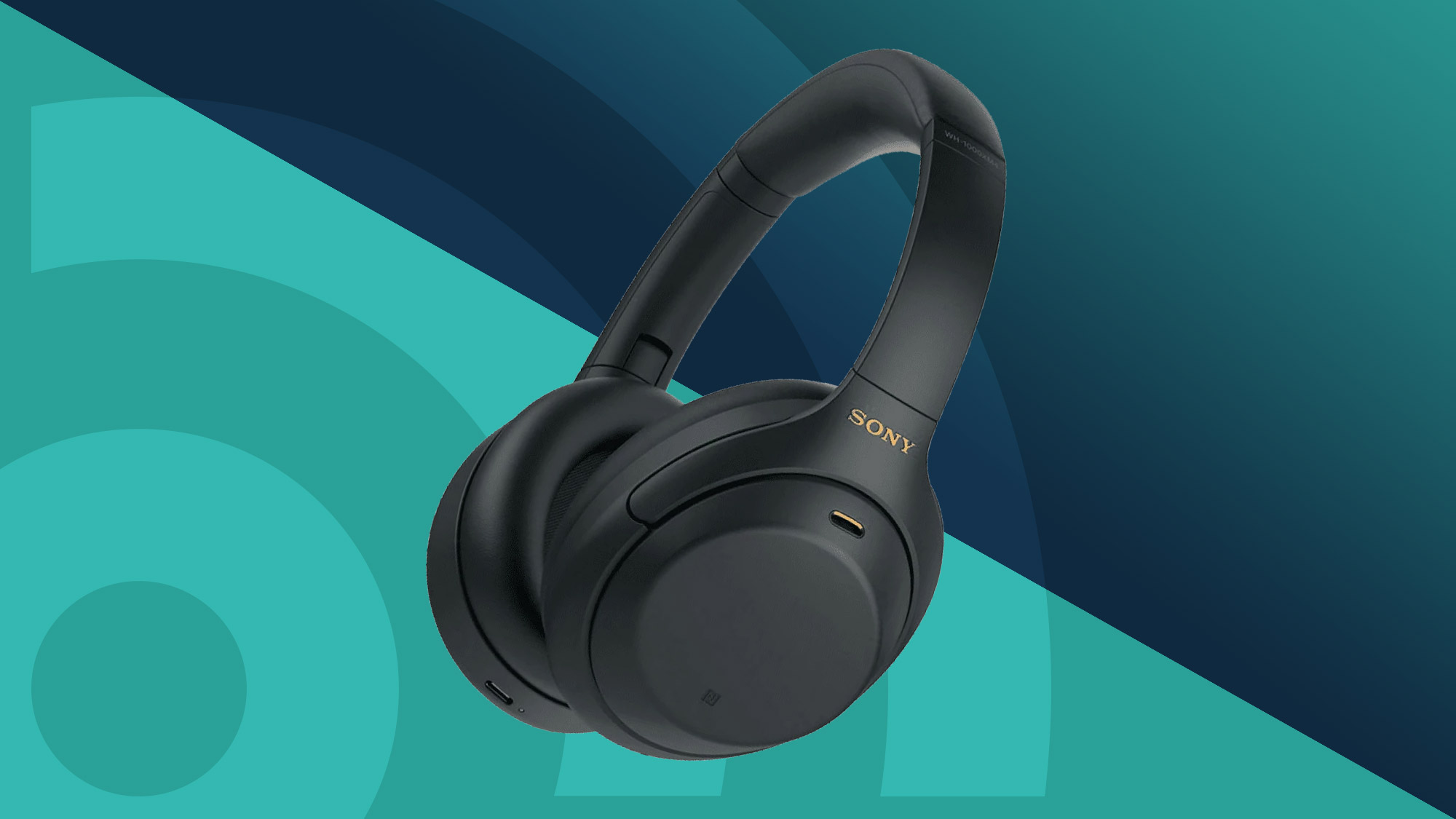
(Image credit: Sony)
Finding the best headphones for you can transform how you listen to music, podcasts and movies, bringing you excellent audio in a sleek design. However, with so many brands, features and styles to choose from, it can be tricky to figure out which are right for you. Do you want over-ear or in-ear? Is battery life your top priority or ANC? That’s why we’ve created this guide, to simplify your search for the perfect pair of headphones.
Our team of experts has been testing headphones and earbuds for over 15 years. With this experience, we know what makes a pair stand out – whether it's exceptional sound quality, superior comfort, or advanced features. Every product featured here has undergone rigorous, real-world testing, and we only recommend models we genuinely love. Our reviews are completely independent, ensuring you can trust our advice.
To put together this guide, we’ve assessed a whole range of factors, including features like AI and spatial audio, through to user-friendly apps, comfort, and overall practicality. Whether you’re exploring over-ear, on-ear, or in-ear styles, you’ll find a whole range of excellent options here. Some models also appear in our popular best wireless headphones guide. For those focused on noise cancellation, check out our best noise-cancelling headphones roundup, for budget-friendly choices, head to our best cheap headphones guide and if you only want a small, convenient in-ear design, you need our best earbuds and best noise cancelling earbuds guides.
Written by

I've reviewed over 150 audio products since becoming a tech journalist, ranging from super-budget earbuds to high-end Hi-Res Audio music players. Before joining TechRadar, I spent three years at What Hi-Fi? testing everything the world of audio had to offer; before that, I was a professional dancer. My love of music ties it all together.
Recent updates
January 2, 2025 Refreshed the introduction and added links to our best earbuds and best noise cancelling earbuds guides. Switched the Nothing Ear (a) earbuds out for the Bose QuietComfort Earbuds as our 'best mid-priced earbuds' option. Added several new picks into our 'also consider' section, including the Shure SE215. Edited our AirPods 4 entry in this section to also include links to our review and our AirPods 4 with ANC review.
The best headphones of 2025
Why you can trust TechRadar We spend hours testing every product or service we review, so you can be sure you’re buying the best. Find out more about how we test.
Below you'll find full write-ups for each of the best headphones in our list. We've tested each one extensively, so these recommendations are based on real-world experience.
The best headphones for most people
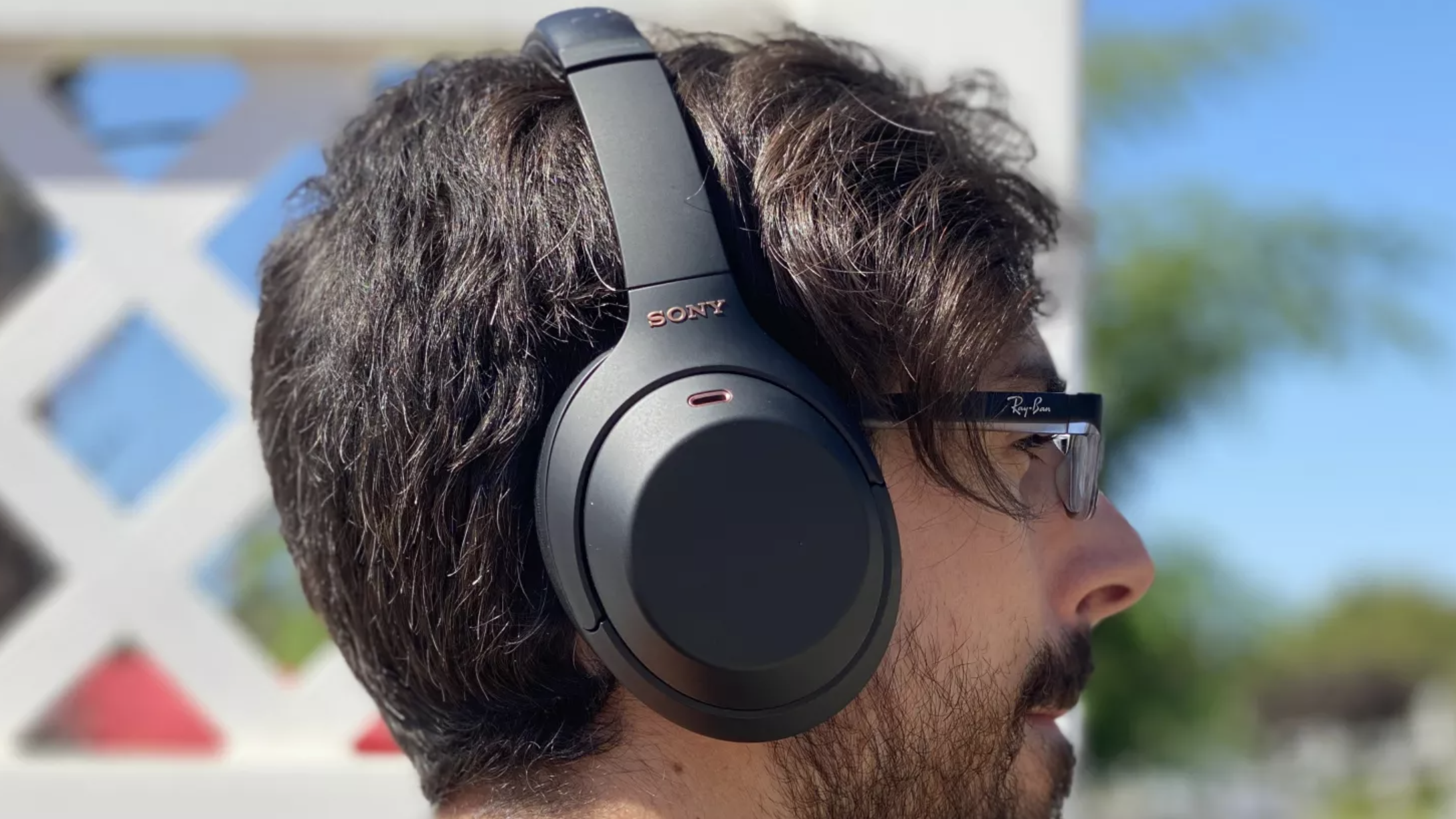
(Image credit: Future)
The best headphones for most people
Specifications
Weight: 253g
Frequency response: 4Hz to 40kHz
Drivers: 1.57-inch dome-type
Battery life: 30 hours
Reasons to buy
Improved noise-cancellation
DSEE Extreme audio upscaling
Multipoint pairing
Auto-play/pause and conversation awareness
Reasons to avoid
-
Imperceptible design changes
-
Not water-resistant
-
Call quality still isn’t perfect
-
Singing can pause the music
Buy them if:
✅ You want versatile headphones that sound good: The Sony WH-1000XM4s deliver high-quality sound in a lightweight folding design that's good for travel.
✅ You want strong noise cancellation: With the volume up and the noise cancelling on, the WH-1000XM4 can block out a lot.
Don't buy them if:
❌ You plan on bringing them to the gym or beach: A looser fit and lack of water-resistance should make you think twice before putting them inside your gym bag.
❌ You take tons of conference calls: While these are great for travel, their call quality isn't that strong.
Despite the fact that the Sony WH-1000XM5 headphones have now been released, we still rate the WH-1000XM4 as the best pick for most people because they're now usually such good value. A combination of a permanent price drop plus regular heavy discounts during sales events means that they can usually be found for a price lower than other premium headphones, while still delivering excellent all-round performance – look for a price under $200 / £200 and you'll be happy.
They sound is weighty by well-balanced, with a warm and inviting tone. They're generous with the bass, but not overly so. The active noise cancellation is very strong too, and though it's been bettered by the Sony XM5 and Bose's latest headphones, it's great for the price if you buy at a discount.
They're bursting with features too, including Sony's DSEE Extreme upscaling for lower-quality music from sources such as Spotify, multipoint pairing for easy switching between devices, auto play/pause when you take them off, Sony's 360 Reality Audio spatial audio, and LDAC wireless support for CD-quality wire-free sound from compatible phones. It's a shame there's no aptX, but it's not a deal-breaker.
They're very comfortable thanks to a lightweight design, and wearing them for long periods is no strain at all. A 3.5mm jack means you can connect them to a wired source easily, though there's no USB-C audio input (the USB-C port is for charging only).
The 30-hour battery life is pretty typical, though is smashed by the 60 hours of the Cambridge Audio Melomania P100 at #3 on the list, which also clearly beat these on sound quality when comparing the two, though as mentioned above, we still think the Sony are great value at their reduced price. That's the story for these headphones at this point: you can find something that does any individual thing better, but nothing that does so much so well as their lower price. But make sure you're paying $200/£200 or under. If Sony bumps the price back up a bit, you're best opting for the Cambridge Audio option – they'll cost the same and bring you even more modern, high-end features.
Read our full Sony WH-1000XM4 review
The best budget headphones
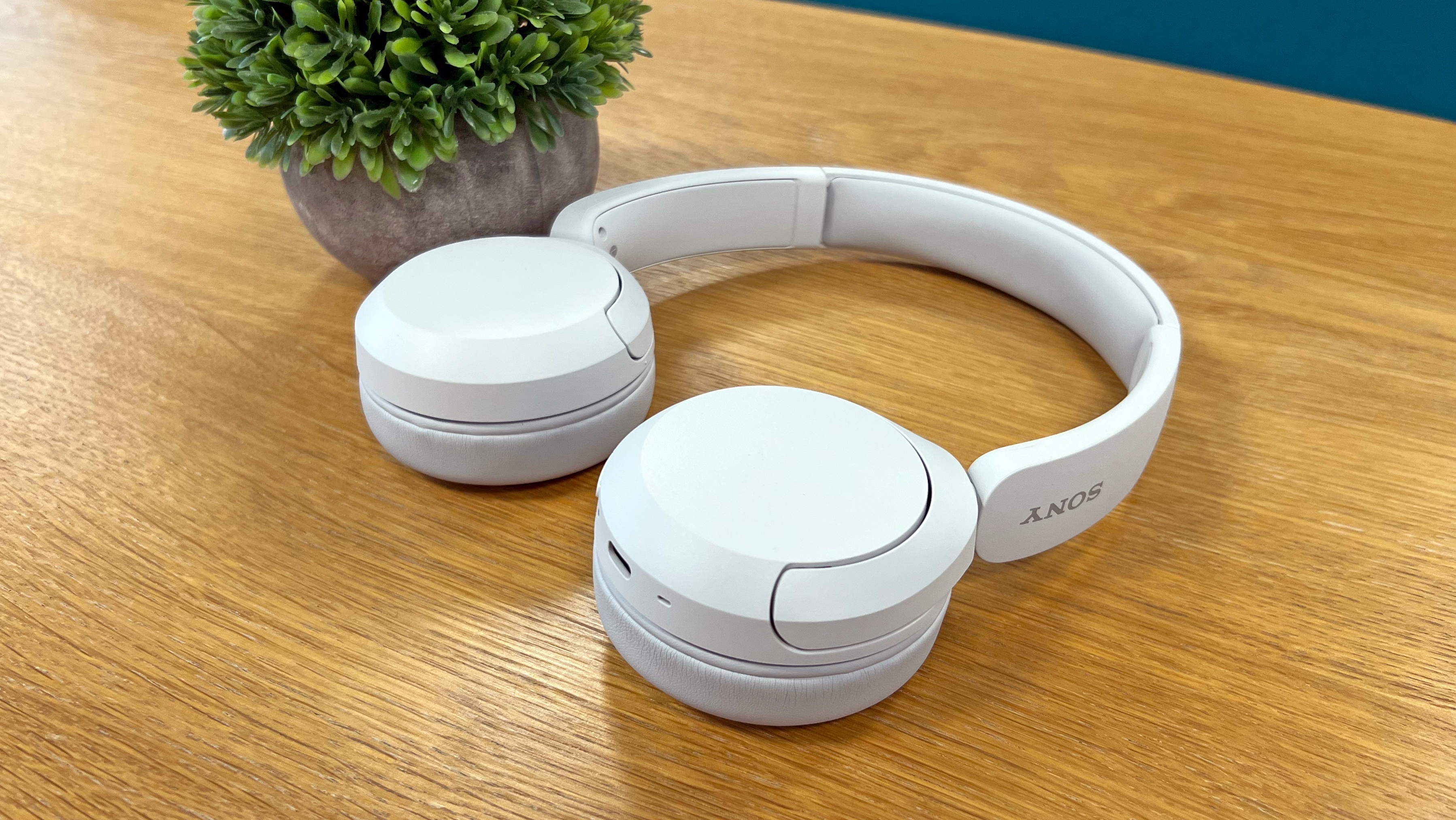
(Image credit: Future)
The best cheap headphones
Specifications
Weight: 4.8 oz
Frequency response: 20Hz-20,000Hz
Drivers: 30mm dynamic
Battery life: 50 hours
Reasons to buy
Incredibly affordable
Impressive sound and battery life
Reasons to avoid
-
No 3.5mm jack or USB audio
-
No active noise cancellation
Buy them if:
✅ You want well-balanced sound: Don't like how bass-heavy or shiny in the treble cheap headphones can be? No danger of that here – they're perfectly tuned.
✅ You love a long battery life: With 50 hours of battery, these will basically always have juice when you need them.
Don't buy them if:
❌ You want active noise cancellation: There's no ANC here, and the passive noise isolation isn't really notable either. Consider the 1More Sonoflow if you need this for cheap.
❌ You're hoping for really audiophile sound: The balance and sound profile is great here, but a cheap pair of wired headphones will sound notably better.
With solid audio, great battery life and Bluetooth connectivity, the Sony WH-CH520 are excellent bang for your buck. If you’re looking for on-ear headphones at this price point, you’re likely already willing to make a few sacrifices. Thankfully, most of the compromises (such as no 3.5mm port option) Sony has made with the WH-CH520 haven’t been too crucial.
The lack of active noise cancellation might be more of a problem, but it certainly isn't unfair for the price. Where the WH-CH520 really shine is a very long battery life of 50 hours and premium features like a customizable control app with DSEE and multi-point audio pairing, which makes switching between devices a breeze.
They are made out of a textured plastic, which is sturdy but admittedly not that premium feeling. Although, again, this is a minor sacrifice for the audio smarts packed inside of them, plus the trade off with such a material is that they're lightweight.
Released in February 2023, they deliver balanced sound that has plenty of detail, making them easy to listen to. Sony really has stripped back features to focus on sound with the WH-CH520, and it really shows with deeper bass and brighter highs.
For those chasing something that is substantially more sturdy or sporting a 3.5mm port, you’re unlikely to find an alternative at the same price point ($60 / £60 / AU$99) that’s also wireless, let alone boasts great battery life and sound.
Read our full Sony WH-CH520 review
The best premium headphones

(Image credit: Future)
The best premium headphones
Specifications
Weight: 330g
Frequency response: Not specified
Drivers: 40mm Dynamic (closed back)
Battery life: 100 hours (ANC off), 60 hours (ANC on)
Reasons to buy
Energetic, informative and convincing sound
Excellent specification
Epic battery life
Reasons to avoid
-
ANC can be bettered
-
No proprietary spatial audio
-
Case is a touch large
Buy them if:
✅ You don't want to think about battery life: 60 hours of longevity per charge with ANC on and 100 without is truly exceptional.
✅ You like an app with lots of options: Everything you need is here to customize your experience, including EQ settings.
Don't buy them if:
❌ You want best-in-class noise cancellation: The ANC here is very good, but the Sony WH-1000XM5 and especially the Bose QuietComfort Ultra Headphones at #7 do it better.
❌ You want light and portable: They're not big or heavy, but they don't fold up as much as they could and the accompanying case is a bit big.
Expect enjoyable and highly engaging sound from the Cambridge Audio Melomania P100 headphones, which we couldn’t fault for the price during our testing. In our review, we wrote: “There’s a stack of detail, a wide-open soundstaging, vaulting dynamic potency and an engaging, lively overall attitude that will keep you coming back for more.” You can also tweak the sound via the app, where you’ll find a seven-band equaliser with several presets.
A pair of premium headphones like these will sound their absolute best with 16-bit/44.1kHz FLAC file action from Qobuz or Tidal, but that doesn’t mean they won’t also do a great job at making any music you throw at them sound incredible. As we wrote in our review: “They don’t judge – give them what you’ve got, and they’ll do their best with it.” The active noise cancellation isn’t the best (look to Bose for that), but it does a good job at nixing most noises – unless you’re looking for exceptional ANC, this will suit most people.
There’s a seriously impressive 100 hours of battery life on offer here, which is incredible. Even compared to some of the best rivals. Admittedly, that’s without ANC, but with ANC on, you’ll get 60 hours, which is still as good as it gets. You’d expect premium features for a premium price and won’t be disappointed. There’s multipoint connectivity onboard, Bluetooth 5.3, six mics to handle ANC, and an app packed with everything you’ll ever need. You’ll also find aptX Adaptive and aptX Lossless codec compatibility. One rather unexpected but hilarious feature is that actor Matt Berry is one of the options for your ‘audible feedback’, which, in our review, we referred to as a “stroke of genius” – seriously, name a better voice actor for this role!
Things are just as positive when it comes to their design. In our review, we wrote that these headphones are “flawlessly built and finished” with a combination of memory foam and vegan leather on the earpads and a padded headband. We also found them comfortable to wear. The only minor downside is that their travel case is a bit bigger than it needs to be. But really, we’re nit-picking.
The Cambridge Audio Melomania P100 are priced at 279/£229/AU279 / £229 / AU279/£229/AU479, which means they’re our top pick if your budget can stretch to the premium end of the spectrum – though it still isn't that premium compared to Sony and Bose's highest-end headphones, so they're actually good value. We awarded them five out of five stars in our review, which is a testament to how great these wonderfully-specced headphones sound and the wealth of features on offer.
Read our full Cambridge Audio Melomania P100 review
The best earbuds overall
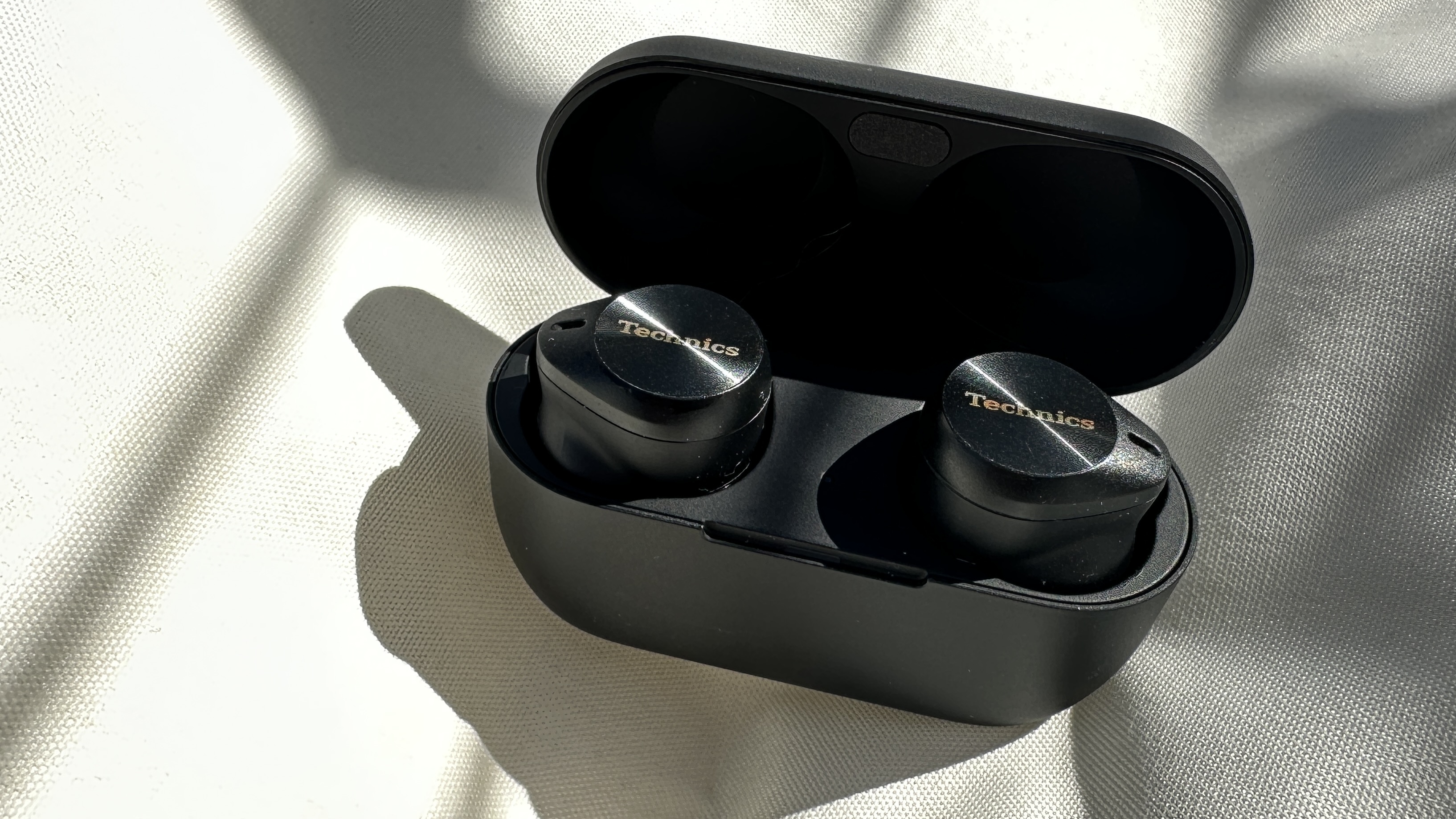
(Image credit: Future)
The best earbuds balancing premium features and price
Specifications
Weight: 7g
Frequency response: 20Hz – 40kHz
Drivers: 10mm
Battery life: (Up to) 7h (earbuds); (up to) 25h (charging case)
Reasons to buy
Excellent, revealing sound quality
Triple-point connectivity
Reasons to avoid
-
Noise cancelling is only average
-
Sound would be perfect if it were more energetic
Buy them if:
✅ Comfort and fit are important to you: These come with loads of different fitting options in the box, so you'll definitely get a secure, comfortable fit.
✅ You want all the features: Triple-point connectivity is a useful world-first, and there's LDAC, customizable ANC, wireless charging… basically everything.
Don't buy them if:
❌ You need best-in-class noise cancellation: The ANC is perfectly average, but Bose's earbuds do a better job of cutting you off.
❌ You want something small and light: They fit well, but they're still heavier than options such as AirPods Pro 2, and they're not small.
The Technics EAH-AZ80 are exactly the kind of package you want from a pair of premium earbuds. Not only do they sound fantastic, they come with some of the most advanced and future-proofed tech of any buds you can buy today, including debuting the first example of triple-device multipoint Bluetooth connectivity, meaning they can be connected to three devices at once and can move seamlessly between them – which worked great in our testing.
You've got Bluetooth 5.3 which can be compatible with next-gen LE Audio, you've got LDAC for CD-quality streaming from compatible devices, you've got highly tweakable noise cancellation and ambient sound modes, a great EQ, wireless charging… basically all the latest toys.
Even more importantly, we're huge fans of their sound quality. It's so poised and eloquent, with a rich dynamic range that feels like you're getting a full and accurate reproduction of the recording. In our review, we said "it's both swift and accurate, as well as balanced and detailed. It’s not quite as energetic as really high-end earbuds, but we can hardly blame it for that – the overall detail and accuracy is a cut above almost anything else."
Technics goes above and beyond to make sure that the earbuds fit all shapes and sizes of ears, providing seven silicone, drop-shaped eartips for their so-called 'concha-fit'.
The battery life and active noise cancellation are less exemplary – both are average, so not bad at all, but not exceptional – but they will be absolutely perfect for anyone looking for excellent musical fidelity and cutting-edge tech features from their earbuds.
Read our full Technics EAH-AZ80 review
The best mid-priced earbuds
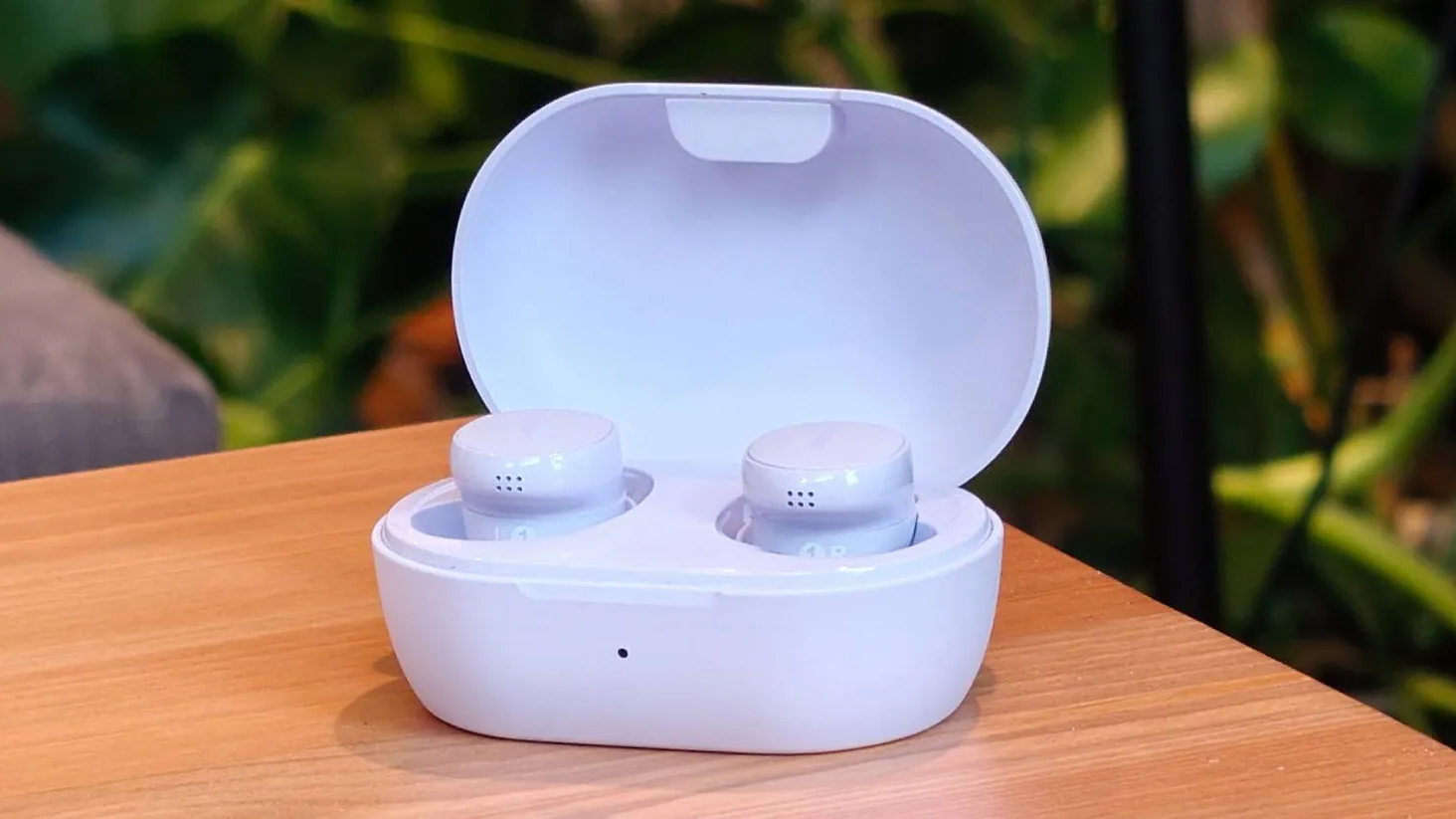
(Image credit: Future)
The best mid-priced earbuds
Specifications
Weight: 8.5g
Frequency response: 20Hz - 20GHz
Drivers: 10mm
Battery life : 8.5 hours buds, 31.5 hours case (ANC off)
Reasons to buy
Fantastic noise cancellation
Comfortable fit
Great sound quality
Reasons to avoid
-
Chunky case
-
Turn off the voice controls
-
Some codecs missing
BUY THEM IF
✅ You want great ANC for less: These Bose buds deliver exceptional noise-stopping power.
✅ You struggle to find buds that fit: They come with multiple tips and stability bands to ensure a comfy, stable fit.
DON'T BUY THEM IF
❌ You want high-res format support: The Bose QCE support SBC and AAC codecs, and that's it. If you want high-res tunes, look elsewhere.
❌ You like using voice controls: Voice commands were disappointing, mostly because they were far too sensitive.
Several great earbuds could claim the title of ‘best mid-priced’ pick, but the Bose QuietComfort Earbuds stand out with exceptional ANC, impressive sound quality, and an incredibly comfortable design. While not exactly cheap, they offer outstanding value for their price.
Bose is renowned for its excellent ANC, and the QuietComfort Earbuds are no exception. In our review, we noted that their ANC “beats out anything else I've tried at this price – and many earbuds that cost much more.” During testing, these earbuds effectively silenced nearly all background noise. For those moments when you need awareness, the Aware mode isolates and amplifies voices while dampening other sounds.
Sound-wise, we described the experience as "warm and energetic," with a "rich and meaty bass." While these earbuds don’t deliver an extra-boosted low end, they offer nuance and perform well even at high volumes. But what we rated the most during testing was the dramatic soundstage. We wrote: “You can hear the different instruments spread around you like dishes at a tapas restaurant, and if you close your eyes you feel like you could point to where each one is.” While they lack support for advanced audio codecs, this won’t matter if you primarily stream via Spotify – but it might disappoint those using Tidal or Apple Music’s high-res offerings.
So many of Bose’s headphones have “comfort” in their name for a reason and these buds delivered a snug and sturdy fit during our testing. There are different tips to choose from, as well as stability bands. We can’t guarantee everyone will get a great fit, but there are few buds we’d say are as likely to deliver as these. In fact, we took them on an 8km run and they didn’t budge. The only thing to point out in terms of design is the case is pretty big, at least bigger than most other wireless buds we’ve tested and it’ll feel bulky in a pocket. Then again, this is hardly a big deal to say these buds are well-priced, sound great, offer solid ANC and fit incredibly well. If your budget can stretch to Bose’s mid-range price tag, these buds won’t disappoint.
Read our full Bose QuietComfort Earbuds 2024 review
The best budget earbuds
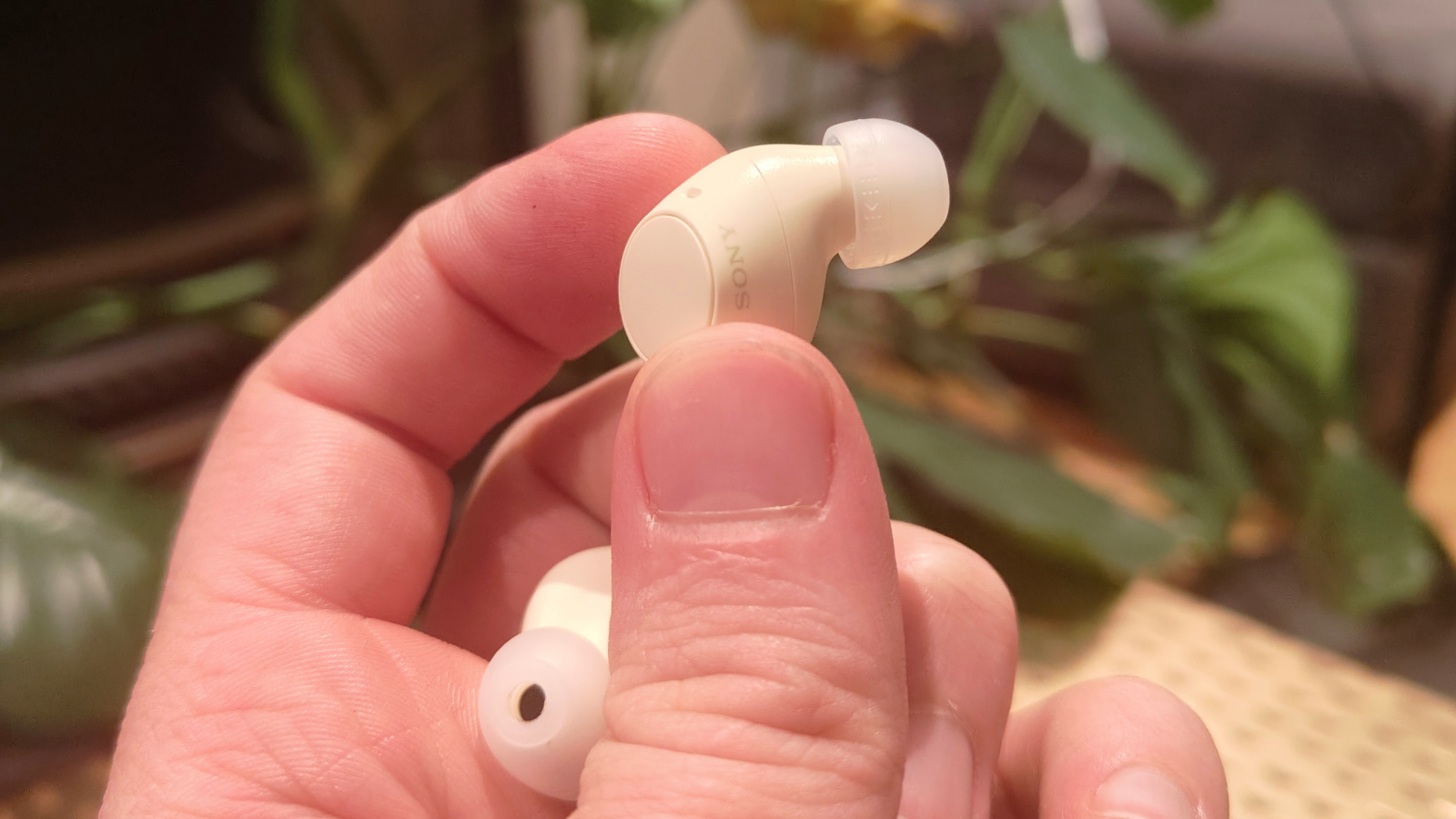
(Image credit: Future)
The best cheaper earbuds, balancing price and sound quality
Specifications
Acoustic design: Closed
Weight: 4.6g each
Frequency response: 20Hz – 20kHz
Drivers: 6mm
Battery life: 11 hours (earbuds) 11 hours (charging case)
Reasons to buy
Great, energetic sound for the price
Sony 360 Reality Audio support
Strong battery life from the buds
Reasons to avoid
-
No active noise cancellation or wear detection
-
Custom EQ isn't the easiest to use
-
Only one charge from the case
Buy them if:
✅ You want affordable buds that don't feel that way: The sound is better than it should be for such a low price, and they're well made and comfortable to wear.
✅ You like clear, treble-first sound: There's no thumping bass here, but audio is clear with textured vocals and a focus on clean treble.
Don't buy them if:
❌ You want noise cancellation: One of the few sacrifices you'll have to make for a budget price here is a lack of noise cancellation – get the Nothing Ear (a) instead.
❌ Longevity is a top priority: The battery in the buds themselves is great, but with the case you'll only get one more full charge.
The Sony WF-C510 earbuds are only 59.99/£54.99/AU59.99 / £54.99 / AU59.99/£54.99/AU109, which makes them budget buds in our books (especially since they'll probably drop in price by about 30% during sales events) but you wouldn’t know it from their quality audio, solid built and good battery life. They’re easily among the best low-cost earbuds we’ve ever tested.
We described the audio from the Sony WF-C510 earbuds as “punchy and high-quality” in our review. We thoroughly enjoyed listening to our favorite tracks with them and noted that Sony is clearly prioritizing clean treble here. You can tweak the experience with Sony’s equalizer, though this isn't the easiest to use. This does mean you may need to look elsewhere – and perhaps pay more – if you’re a fan of powerful bass.
There are a couple of missing features here that you’d find in pricier, mid-range earbuds. The main one is active noise cancellation, but there’s also no wear detection or low-latency mode. Then again, when you considering the asking price here, it’s hard to complain. Sacrifices need to come from somewhere, and it makes sense they’d come from features rather than sound and fit. The buds have a solid 11 hours of battery, which should see you through a long work day and most journeys. However, the case battery life is less impressive, also packing in 11 hours – so you get one full charge of the buds from it. Compared to rivals, this is a little low. We’d expect at least two full charges.
We highly rate the simple design of these Sony buds. They stay very stable in your ears. There’s a nice grippy material on the tips, which is one of the reasons they fare so well in all sorts of settings. In our review, we wrote: “I even cycled confidently with them and completed a full workout at the gym without gravity doing its thing to them.” Each bud also weighs less than 5g, which makes them comfortable and lightweight for all-day wear. The case is light and will easily fit in a pocket without feeling like you've got a lumpy thigh.
These are some of the best cheap earbuds you’ll find, and they prove that Sony isn’t just good at building the top high-end headphones, like the Sony WH-1000XM4 over-ears at the top of this list or the high-performing Sony WF-1000XM5 earbuds, but can turn its hand to more affordable tech, too.
Read our full Sony WF-C510 review
The best headphones for ANC
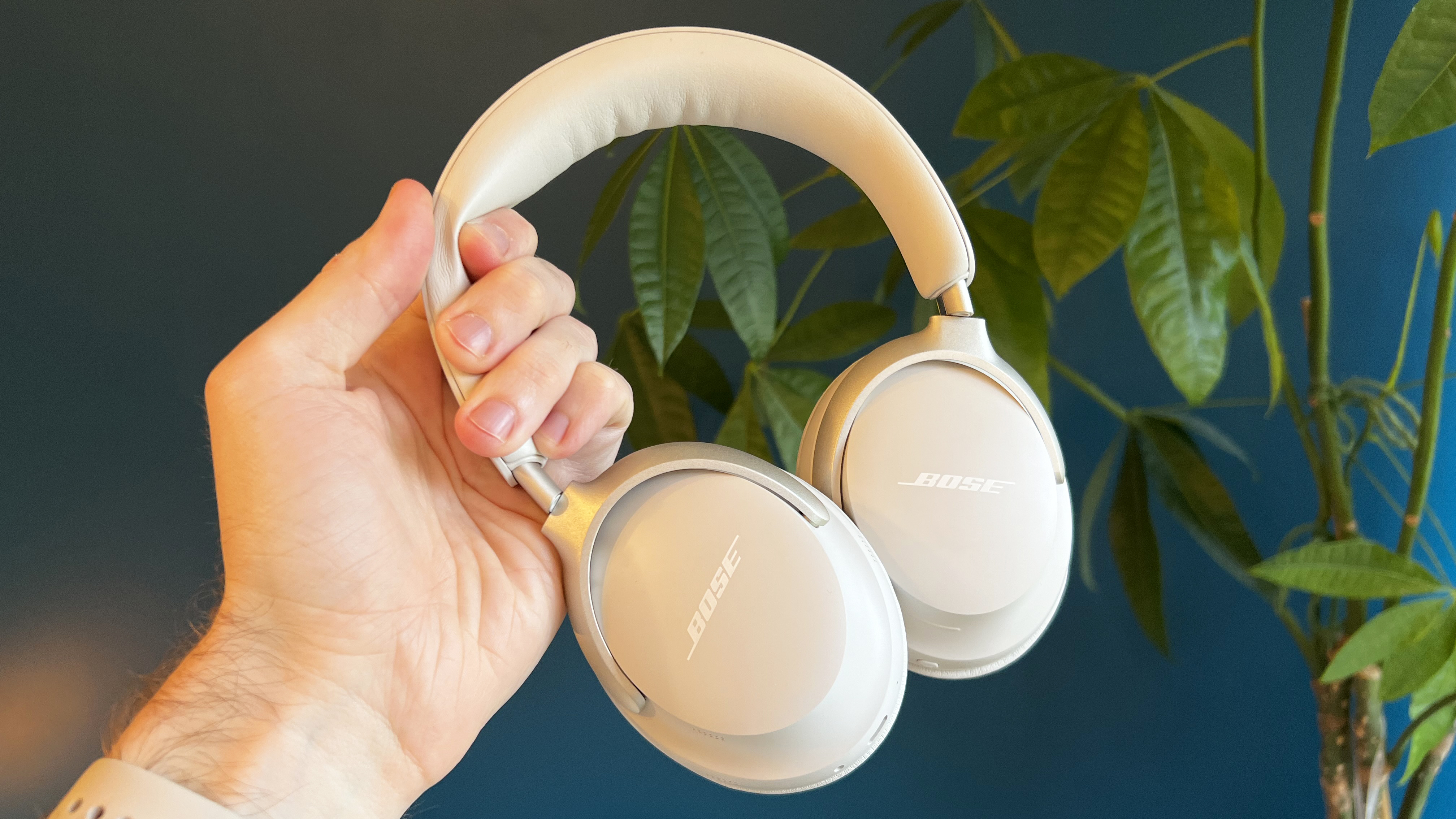
(Image credit: Future)
The best headphones for active noise cancellation
Specifications
Weight: 250g
Frequency response: Not listed
Drivers: 35mm
Battery life: 24 hours
Reasons to buy
Fantastic, detailed sound with rich bass
Class-leading noise-stopping power
Comfortable and premium, with folding design
Great smart features
Reasons to avoid
-
24-hour battery life is weak
-
Some will prefer a more neutral sound
-
No USB-C audio input
-
No LE Audio support (but it's promised)
Buy them if:
✅ You want the best noise cancellation: That's the long and short of it. They're the best. A clear step up over anything else (except the Bose QuietComfort Headphones, which are 95% as good).
✅ You want exciting, nuanced, rich sound: These are Bose's best-sounding headphones by a long way – they're wonderfully dynamic and detailed.
Don't buy them if:
❌ You want a long battery life: The 24 hours of battery life here is pretty disappointing – not a dealbreaker, but below Sony and way below Cambridge Audio.
❌ You want Hi-Res Audio connectivity: Despite a high cost, there's no USB-C Hi-Res option, and no broad aptX or LDAC support.
These are Bose's most exciting headphones in years, and they put the inventor of active noise cancellation right back on top of the category it created. They're in a class of their own when it comes to blocking outside sound, and we tested then on planes, trains, buses, in bustling cities, in the office, and at home – and in all cases, they silence the create was more complete than anything else we've tried (though obviously, some stuff will still leak through).
But what's so exciting is that on top of this, they also sound simply fantastic. As we said in our review: "They deliver some of the most alive, exciting, textured, finely resolved, deeply engaging music I've ever heard from a pair of wireless headphones." This sound quality comes at a premium, but we think they're easily worth the higher price over the likes of the Sony or Cambridge Audio headphones here. "The Bose QuietComfort Ultra Headphones may not be cheap, but on the music quality alone, I think they're a great deal," our review says.
They also have some good smart features, including customizable active noise cancellation modes and multipoint connectivity, controlled from the generally intuitive Bose Music app.
It's a bit of a shame that higher-quality audio support is limited to Snapdragon Sound with compatible phones, and the 3.5mm audio cable. Several audiophile competitors (the Cambridge Audio Melomania P100 in this guide, and the Shure Aonic 50 Gen 2) have USB-C audio support for serious hi-res files, and aptX for broader high-quality wireless tech (or LDAC).
The 24-hour battery life is also lower than the 30 hours that's standard for noise-cancelling headphones, and massively lower than the 60 hours for the Cambridge Audio headphones in this list. But we can forgive all these faults for the sound quality on offer here.
Read our full Bose QuietComfort Ultra Headphones review
The best earbuds for ANC
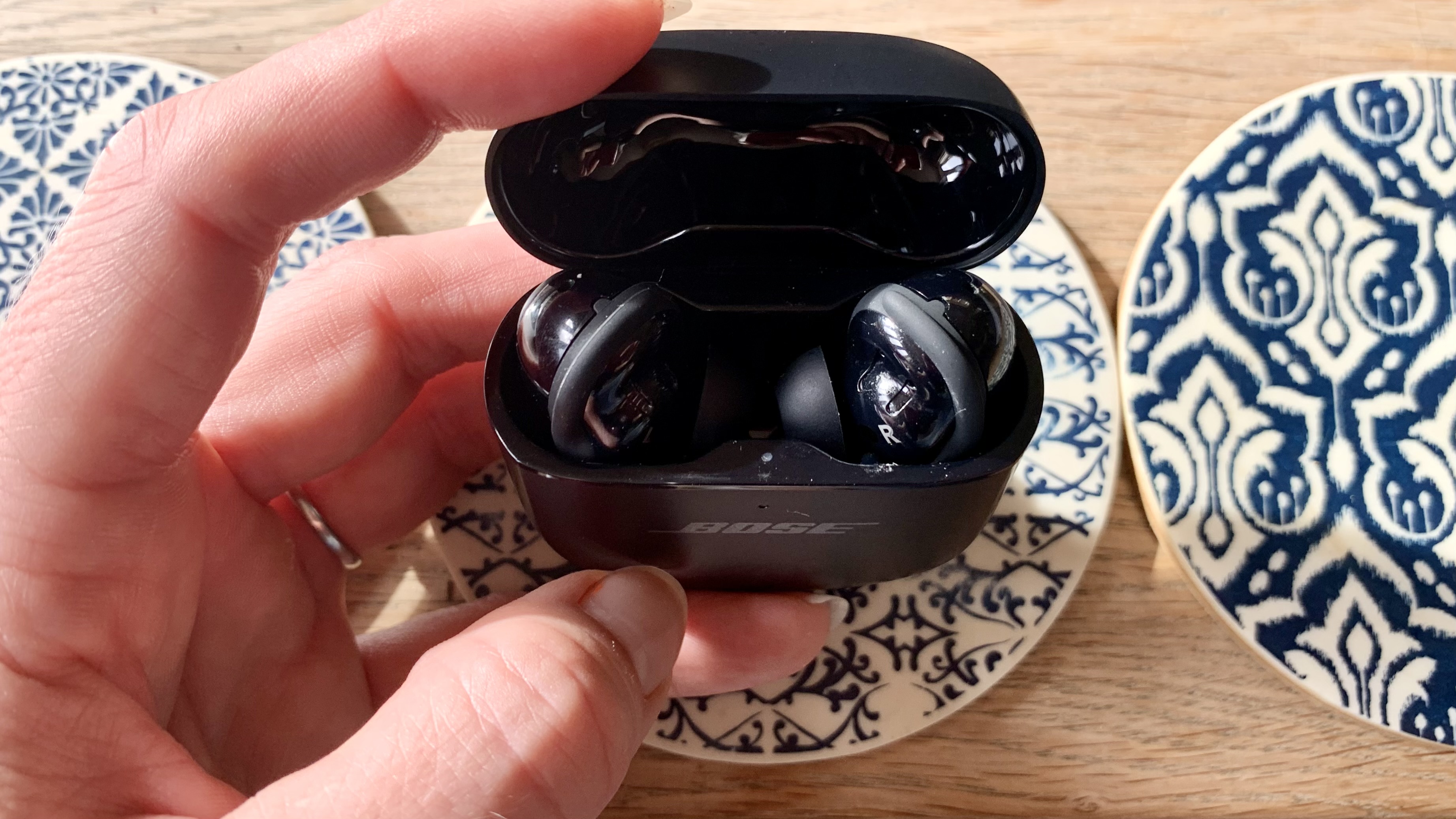
(Image credit: Future)
The best earbuds for active noise-cancellation, hands down
Specifications
Weight: 6.24g per earbud
Frequency response: Not listed
Drivers: 10mm
Battery life: 6 hours (buds) 24 hours total (with case)
Reasons to buy
Excellent device-agnostic head-tracked spatial audio
Lossless audio codecs supported
Still the best noise-cancelling in a set of earbuds
Reasons to avoid
-
Case can't charge wirelessly unless you buy a cover
-
Physically quite similar to the QCE II
Buy them if:
✅ You need elite active noise cancellation: simply the best ANC in earbuds that you can get.
✅ You love a vivacious, full-on sound: Bose has really nailed zealous sound in these buds, paticularly when using the immersive audio features alongside the ANC.
Don't buy them if:
❌ You want wireless charging: you can get it, but you'll need to purchase a separate cover
❌ You like a smaller, lighter earbud: These are smaller than Bose's last offering, but it's still chunkier than average, and you do feel it in your ear.
The Bose QuietComfort Ultra Earbuds are just the best noise-cancelling earbuds on the market now. Not necessarily the most neutral and detailed-sounding across the board, you understand, but the best if you need a bubble-of-silence background to better hear your tunes. They take everything we loved about the QuietComfort Earbuds 2 that came before them and add some major improvements, including excellent device-agnostic head-tracked immersive audio, special tweaks to the ear-tips, multipoint to two devices (following a July 2024 update) and even better ANC.
As you’d expect, the active noise cancellation (ANC) here is top notch, creating a "near cocoon of silence" that’s perfect for shutting out extraneous noise. Combine their ANC prowess with an acceptable 6 hours of battery life in the buds and 24 hours in total with the case, and they’re a solid choice.
The all-new Immersive Audio technology also offers spatial sound that adapts to your movement and works with the ANC, offering a more cinematic experience across devices – all with Snapdragon Sound Suite and aptX Adaptive support at the helm. We called them a “vigorous and engaging listen” in our review and that's what you're getting. Don't expect the most analytical, detailed or dynamically nuanced soundfield, but unless you want audiophile-grade audio, you'll be well served here.
Read our in-depth Bose QuietComfort Ultra Earbuds review
The best headphones for sound quality
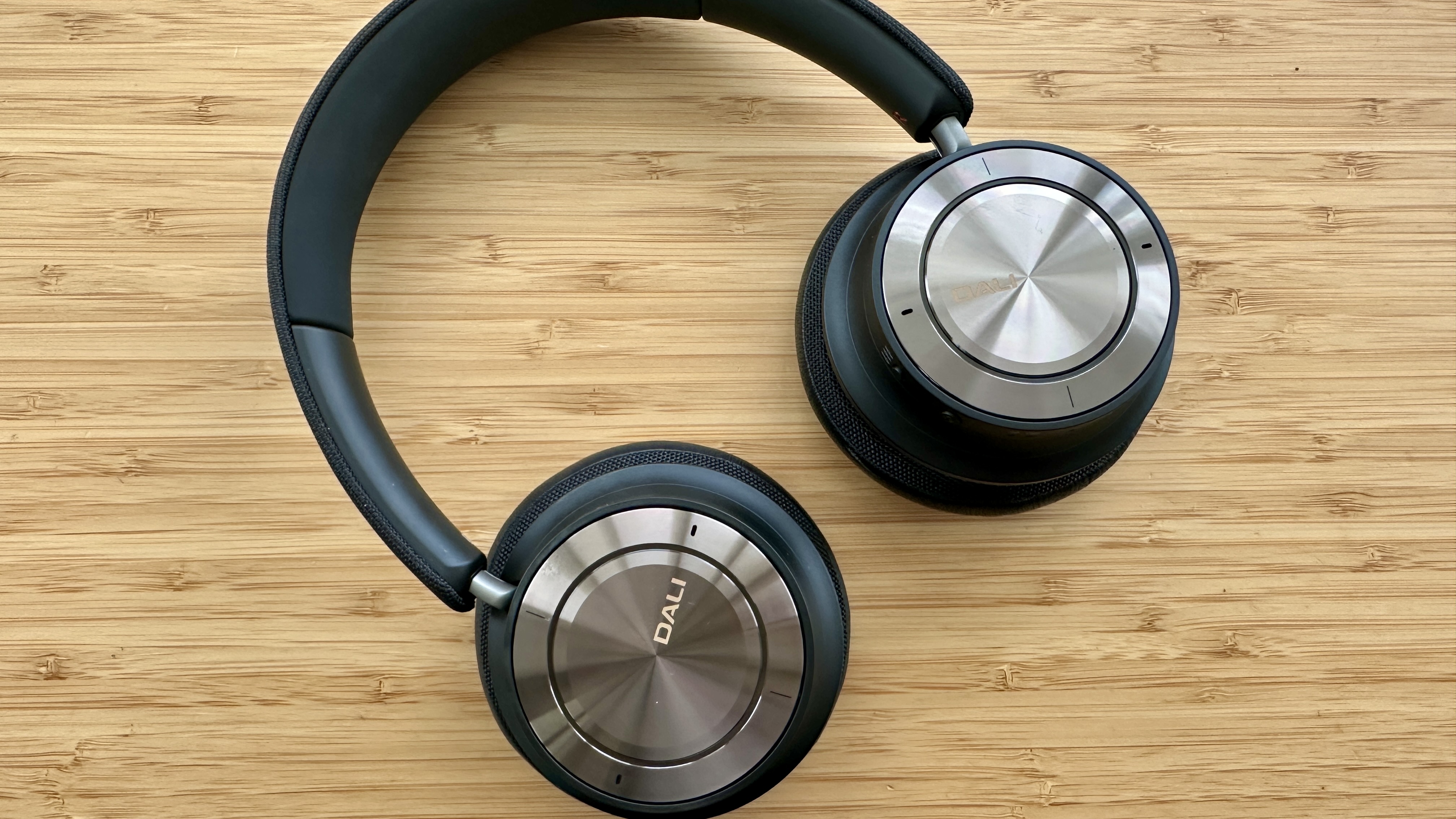
(Image credit: Future / Simon Lucas)
The best headphones for wireless sound
Specifications
Weight: 325g
Frequency response: 10Hz-43kHz
Drivers: 50mm
Battery life: 35 hours (ANC off); 30 hours (ANC on)
Reasons to buy
Positive, detailed and completely convincing sound
Can happily function as hard-wired passive headphones, too
Outstanding standard of build and finish
Reasons to avoid
-
No control app
-
No vegan option
-
Plenty of credible competition
Buy them if:
✅ You like your devices to be of a high standard: They look and feel premium, which is to be expected for their price, of course.
✅ You want clear, rich sound: We were incredibly impressed with the performance of these over-ears during our testing.
Don't buy them if:
❌ You want a vegan option: Leather is used on the exterior of these headphones, which is a shame if you're don't want to buy animal products.
❌ You like to customize your listening: There are only two EQ settings for the Dali IO-8, the lack of an app will be a dealbreaker for some.
The Dali IO-8 over-ear headphones have been built to an exceptionally high standard, but they truly shine where audio quality is concerned. We genuinely couldn't pick fault with them during our testing, so it's easy to see why they're our top pick if sound is your top priority above all else.
Features-wise, these headphones are packed with most of the high-tech goodies you'd expect, including Bluetooth 5.2 with aptX Adaptive compatibility, 24bit/96kHz support and 50mm full-range drivers with 10Hz-43kHz frequency response. You'll also get a decent 30 hours of battery life with ANC on. The only thing missing is a control app, meaning you can't tweak sound profiles – then again, when they sound this good, why would you want to?
The Dali IO-8 deliver audio that we described as "detailed and expansive" in our review, stating that "no element of a recording is too fleeting to elude them." There's also wonderful richness and clarity across the whole range and a tonality we called "carefully neutral". ANC is here and it's good, but it's not best-in-class, look to Bose for that.
These headphones deliver in the looks department as well as sound, with a high level of build and finish quality. The design is also nice to look at, with perfectly circular ear cups. They're comfortable thanks to memory foam in the cups and an adjustable headband. We also like that, if you forget to charge them, you can listen to these headphones wired, too. A great option for ultimate convenience. The only drawback is leather has been used on the exterior of the cups, which means vegans should steer clear.
Of course, the Dali IO-8 are not cheap. But if high-quality sound and an equally impressive build are what you're after – and you're happy with no app and leather – they're well worth your money.
Read our full Dali IO-8 review
The best earbuds for sound
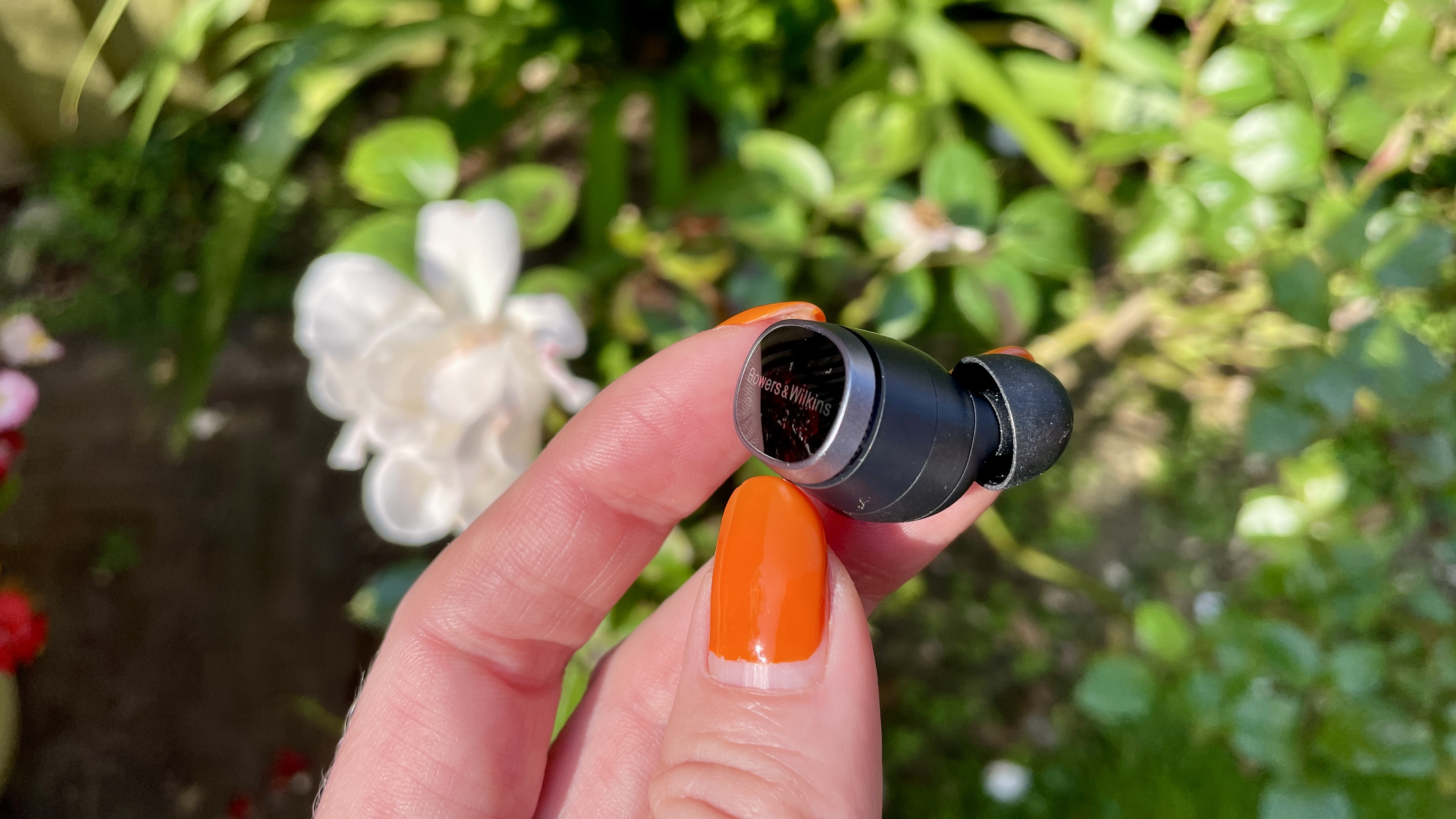
(Image credit: Future)
The best earbuds for stunning sound
Specifications
Weight: 7g (per earbud)
Frequency response: Not specified
Drivers: 12mm carbon cone
Battery life: 6.5 hrs (buds), up to 20hr total
Reasons to buy
Incredible detail and dynamic range
Comfortable for big buds
Effective noise cancellation
Reasons to avoid
-
Lacks ear-tip or fit tests
-
No spatial audio
-
Battery life can still be beaten
Buy them if:
✅ Excellent sound is your top priority: These B&W buds sound fantastic and are among the best we've ever tested – that's really saying something.
✅ You want the option of wired listening: You can connect the case to a laptop or in-flight entertainment system, and the sound will beam to the buds.
Don't buy them if:
❌ You want spatial audio: There's no option for this – not a problem for music purists, but a shame for movies.
❌ You'd like full controls on the buds: It's a small bugbear really, but you can't control ANC modes and volume from the buds at all times.
The Bowers & Wilkins Pi8 are a highly competent pair of buds that sound fantastic and are a joy to wear. This easily makes them our top pick for those who want the best sound from the super-convenient true wireless buds design. Bowers & Wilkins has always created audio tech that sounds phenomenal, and these latest buds are no exception.
To say that we were impressed during our testing is a massive understatement. In our review, we wrote: “No matter what genre of music I threw at them (and no matter the streaming source) it felt as if the B&W Pi8 had unpacked, weighed, opened out, examined, layered and finally presented my music with the skilled hand of a French pâtissier.” They excel in all areas, including dynamic nuance, balance, musicality and more. Audiophiles will be delighted to hear such clarity and richness from a pair of buds.
Features-wise, there’s a lot to love here, including the noise cancellation. It’s rare to find both incredible sound and ANC – sometimes solid noise cancelling comes at a price and that price is a loss of richness and clarity. In our review, we wrote: “That cocooned feeling of leaving the outside world behind kicked straight in.” This is due to B&W’s advanced tech, of course, but also thanks to the snug and stable fit of the Pi8 buds. As well as ANC, there’s a ‘Pass Through’ mode that lets you hear people talking to you. But other than that, there are no different levels of noise blocking power to choose from here, which is something Bose offers you, for example.
Another great additional feature is that the charging case can be plugged into a non-Bluetooth source, and it’ll then become a wireless audio re-transmitter in aptX Adaptive transmission up to 24-bit/96kHz quality. This makes the buds perfect for listening to movies on in-flight entertainment systems, or using with work laptops and so on.
The only thing really missing here is there are no fit tests to make sure the ear tips are right or that the noise cancellation is geared to you. There’s also no spatial audio processing, which is a bit of a shame for movie lovers in particular. These aren’t essentials by any means, but you could try the Bose QuietComfort Ultra Earbuds, the LG Tone Free T90S or the AirPods Pro 2 if spatial audio is a priority.
The Pi8 buds boast an improved design over previous versions, which adds on-ear volume support (but annoyingly no ANC on or off function) and nixes connectivity issues. There are several color options to choose from, and although they’re made from plastic they do have a premium, matte look and feel to them. They have slightly better battery than the buds that came before them, but it’s not a huge improvement. You’ll get 6.5 hours from the buds and 13.5 hours more from the case with noise cancellation on. Other buds do it better, but that’s a substantial amount of time for a work day or most journeys. The Bowers & Wilkins Pi8 buds may not be cheap, but considering they deliver best-in-class audio in buds that are hard to fault in almost every conceivable way, they’re excellent value.
Read our full Bowers & Wilkins Pi8 review
The best looking headphones
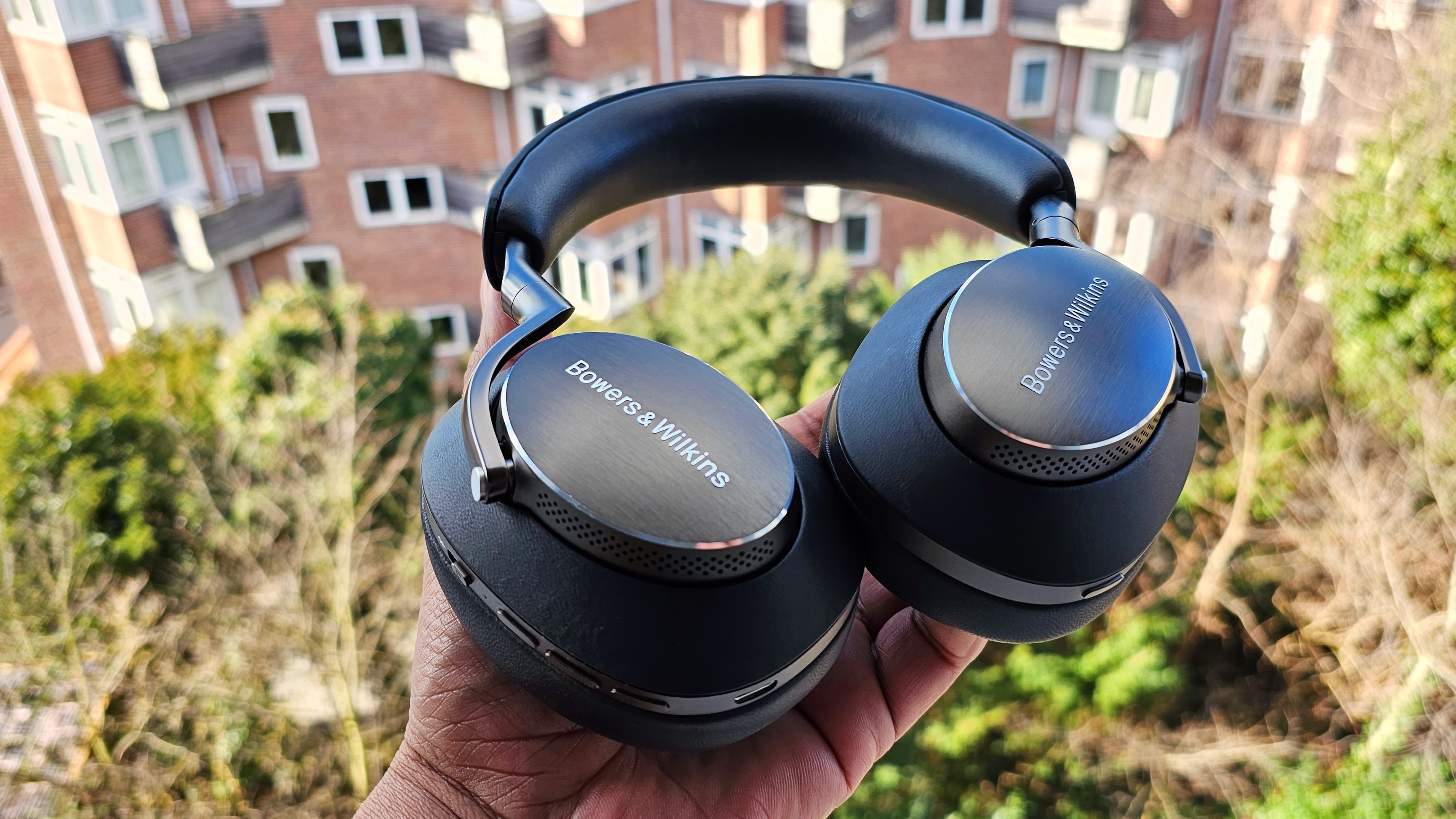
Bowers & Wilkins PX8(Image credit: Peter Hoffmann)
The best headphones for sumptuous design
Specifications
Acoustic design: Closed
Weight: 320g
Frequency response: Not listed
Drivers: 40mm dynamic full range
Battery life: 30 hours
Reasons to buy
Agile, detailed, class-leading sound
Supreme comfort during wear
Classy build and finish
Reasons to avoid
-
Battery life has been beaten
-
Noise cancellation is average
-
Expensive
Buy them if:
✅ You like the luxe experience: With beautiful metal finishing and rich leather, these feel premium and beautifully built.
✅ You want stunning sound: These are as good as the Focal Bathys for sheer audio quality – they're supremely expansive, natural and insightful.
Don't buy them if:
❌ You want light, travel-friendly cans: Much like the Focal above, these are fairly weighty and don't fold up for traveling.
❌ You want high-end noise cancellation: The Bose QuietComfort Ultra Headphones are a huge improvement on these for noise blocking.
Another one for the audiophile crowd, the sound quality of these headphones is right up there with the Focal Bathys as being the best we've heard from wireless headphones. Bowers & Wilkins' history is in full force here, bringing the refined, hi-fi-like sound quality you'd expect from the company – but it comes with a high price.
In our review, we said these headphones "sound as three-dimensional and energetic as we've heard in a wireless design", with an "agile and expansive midrange" and "expressive and weighty" low end. Compared to the likes of the Sony WH-1000XM5, we said that "The extra energy, depth, emotional oomph and overall immersion in excellent-quality music place the PX8 in a different league." And we love both those headphones, but you pay twice as much, and you'll hear the difference.
And you don't just hear it. The premium design is what we've promoted these headphones for here, and they're a beautiful balance of subtlety and flair, thanks to their used of diamond-cut aluminum details and sumptuous Nappa leather for comfort. (Sorry, vegans, though the Bose QuietComfort Ultra Headphones feature only synthetic leather, and are fantastic.)
The PX8 are more average when it comes to battery life (30 hours is exactly what we consider the norm) and the active noise cancellation (it's effective, but it's behind Sony and Bose's best). But it has some great smart features, including good control via its app, and USB-C audio support for truly Hi-Res Audio, as well as aptX Adaptive for CD-quality sound wirelessly.
They may be expensive, but they offer so much quality, and with a gorgeous design that really feels worth that outlay, and looks closer to an objet d'art than the competition.
Read our full Bowers & Wilkins PX8 review
The best wired earbuds
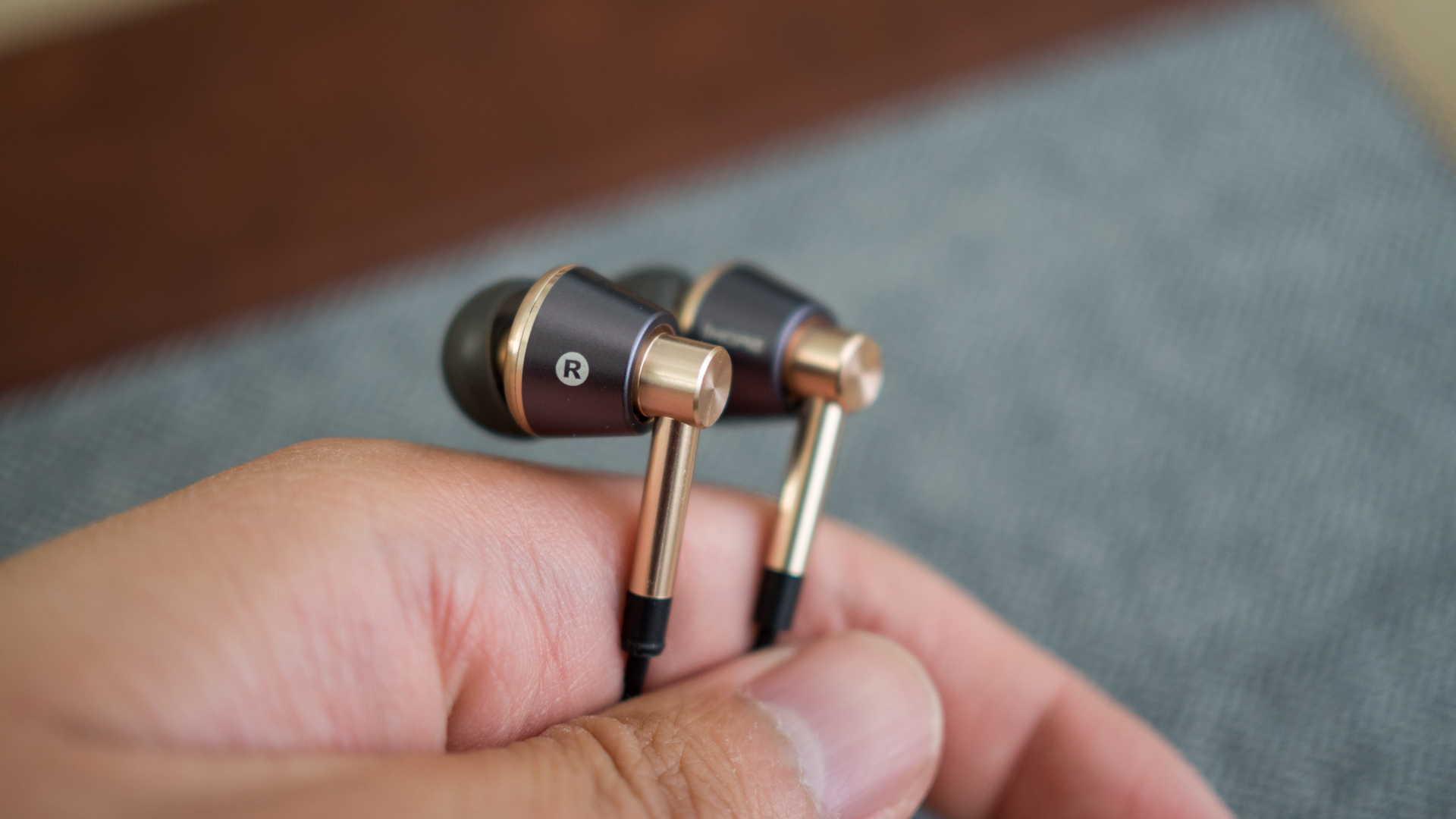
(Image credit: Future)
The best wired in-ear headphones for most people
Specifications
Weight: 18g
Frequency response: 20Hz – 40kHz
Drivers: Dynamic
Battery life: N/A
Reasons to buy
Lush sound quality
Excellent build and design
Unmatched value
Reasons to avoid
-
Rubber cable catches on itself
-
Plastic remote feels cheap
Buy them if:
✅ You want uncompromising sound: Audio quality is where the Triple Drivers stand out, delivering a balanced yet detailed sound with mid-bass.
✅ You want the best possible value: At this price range, it's hard to find headphones that can match the level of quality build and design you're getting.
Don't buy them if:
❌ You don't like wires: The biggest gripe we had with these headphones is that the rubber cable would catch on itself, which can be distracting when listening on the go.
❌ You value quality materials: Another minor flaw we found during our testing was that the plastic remote feels cheap, like the rubber material used for the cable.
These deliver fantastic sound and equally fantastic value for money. The audio quality in the 1MORE Triple Drivers truly does shine above the rest for its balanced sound. It has a slightly warm signature beat that we grew to love.
We consider them to be the best headphones for the price, especially if you prefer wired earbuds. For 100/£100(aboutAU100 / £100 (about AU100/£100(aboutAU168), it’s hard to find a better-sounding and more well-built pair of earphones than the 1MORE Triple Drivers.
The biggest nitpick we had during our testing was that the rubber cables can catch on themselves as well as your clothes. As an alternative, if you want a little extra refinement and more luxurious materials, the same firm's 1MORE Quad Drivers are even more impressive, albeit at twice the price.
At this price, with such excellent build and design, it’s hard to fault the Triple Drivers. The inbuilt remote feels a little cheap, but that's more than made up for by the lush sound quality offered by these luxe-looking earbuds. For the price, you can't do better than 1MORE's Triple Driver in-ear headphones.
Read our full 1More Triple Driver In-Ear Headphone review
Other headphones to consider
Nothing Ear (a): These earbuds may no longer be in our guide, but they're still an excellent choice for most people. The only reason they left is because the Bose QuietComfort Earbuds that replaced them are a little better for mid-range money. However, as you'll see from our Nothing Ear (a) review, they're still great and are actually quite a bit cheaper.
Shure SE215: Take a look at our Shure SE215 review for a good wired, in-ear option. These earbuds will bring you solid noise isolation and great bass output, but they fell short with their occasionally cluttered soundstage.
Shanling HW600: We realize that the market for very premium, wired over-ears with excellent sound, no ANC made specifically for people with large heads is niche. But, if that's you, congratulations! You just found your headphones. Take a look at our Shanling HW600 review to find out more.
Apple AirPods 4: We've been busy testing the two new versions of the AirPods 4, and you can now read our thoughts in our Apple AirPods 4 review and our Apple AirPods 4 with Active Noise Cancellation review. Both earbuds work well, and we do recommend them if you love Apple products and have an iPhone – especially if you've been waiting for ANC in a pair of AirPods. But the upshot is you can do better for the money, and there are plenty of options in this guide we think will suit you more.
Marshall Monitor III ANC: We're also testing the latest Marshall Monitor III ANC over-ears. These cans have a rugged, retro design that's incredibly comfortable, great sound, and an impressive 70 hour battery life. We'll share our full review soon and decide whether they've got what it takes to make this best headphones guide, but for now read our early hands on Marshall Monitor III ANC review.
Sonos Ace: Sonos' first headphones are a very premium price, and have a design to match. But the audio quality for music is a step behind the Bose QuietComfort Ultra Headphones we recommend above. However, we absolutely loved them for their movie performance and spatial audio, either when used with a Sonos soundbar or with any Dolby Atmos-capable device – if you're a big movie fan, you should still read our Sonos Ace review.
Sony WH-1000MX5: We really like these headphones, as you can see in our five-star Sony WH-1000MX5 review – but they're beaten in key areas by other products that are keeping them out of this guide, essentially. The Cambridge Audio Melomania P100, for example, are more detailed and offer twice the battery life, while also being less expensive. It's a cut-throat world of headphones.
Meet the team
Our team of reviewers has collectively amassed years of audio tech experience and testing, rigorously putting all of the latest and greatest headphones through their paces.

Matt is TechRadar's Managing Editor for Entertainment. He oversees our movie and TV show coverage, as well as our reviews and news of the latest televisions, soundbars, headphones and speakers. Matt managed TV and audio content for T3.com, and before that he was the Editor of T3 magazine. He's also written for other tech titles, including Creative Bloq, PC Gamer, Digital Camera World, Edge, Official PlayStation Magazine, PC Plus, MacFormat and many more.

Becky is TechRadar's Audio Editor. She joined TechRadar in 2022 as Senior Staff Writer, focusing on all things audio and hi-fi. Becky spent three years at What Hi-Fi? where she tested and reviewed everything from wallet-friendly wireless earbuds to huge, multi-product high-end sound systems.

Nick Pino is the Managing Editor, TV and AV for TechRadar's sister site, Tom's Guide. He was previously the Senior Editor of Home Entertainment at TechRadar, covering TVs, headphones, speakers, video games, VR and streaming devices. Nick has also written for GamesRadar+, Official Xbox Magazine, PC Gamer and other outlets over the last decade, and has a degree in computer science.

Simon Lucas is a freelance tech journalist focusing on the audio/video aspects of home entertainment. Simon was editor of What Hi-Fi? magazine and whathifi.com. He's also written for titles including Wired, Metro, the Guardian, HiFi+ and GQ. He's also worked as an audio consultant for some of the world's most high-profile consumer electronics brands.

Tom was previously the deputy phones editor at TechRadar until late 2022 reviewing all sorts of tech, including phones and tablets. He now works for the entertainment site What To Watch. He has spent years freelancing in tech, gaming and entertainment journalism.

Sharmishta is Managing Editor for TechRadar's APAC region. This means she looks after Australian, New Zealand and Singaporean editions of the site. She manages news, reviews and features, as well as ecommerce content. She has knowledge in all sorts of tech, including e-readers, smart home devices and headphones.
How to choose the best headphones for you
One of the key parts of being able to choose the best headphones for you is knowing what you're talking/reading about. There's a lot of jargon around headphones, so here's an explanation of all the key terms you'll need to know when buying headphones today.
Active noise cancellation (ANC): A way of processing audio to counteract extraneous sounds around you and remove them from what you’re hearing. Microphones on the outside of the headphones listen for ambient external sounds, then create an ‘antiphase’ (often called ‘anti-noise’) soundwave, which is mixed into your music to ‘cancel out’ the ambient noise. This means you can listen to music at lower volume levels, or can hear podcasts more clearly.
aptX: A higher-quality audio streaming system from compatible devices, that works over Bluetooth, but is capable of streaming higher-resolution files. There are multiple versions of aptX, but in new headphones you are mostly likely to see aptX Adaptive, which can work at different quality levels depending on connection strength. You may also see a reference to aptX Lossless, which is part of aptX Adaptive, and is the highest-quality connection the tech currently offers. There is also aptX Voice, which is designed to make your voice clearer on calls, and is also part of aptX Adaptive.
Auracast: A new Bluetooth connection system, still in its early stages. It enables you to connect Auracast-ready headphones to any Auracast transmission source without needing to ‘pair’ your headphones in the usual Bluetooth method, meaning that you could connect to a TV in a bar to hear a sports game, or connect to your airport gate to hear announcements. It was developed for hearing-aid use, but will be supported by a large number of headphones due to its convenience.
3.5mm jack: The classic wired connection for headphones – not all of today’s wireless headphones support this, though, so we make sure to highlight it, for when only wired use will do.
Bluetooth: The technology that effectively all headphones rely on for a wireless connection. It is capable of supporting many different music streaming technologies, including aptX, LDAC and LHDC. The two standard and most common streaming technologies are called SBC and AAC, and are supported on the vast majority of earbuds. There are many different versions of Bluetooth, and higher versions enable newer features such as Bluetooth LE Audio or Auracast – however, supporting a new version of Bluetooth doesn’t guarantee that these technologies are supported, so always check the specs. Bluetooth 5.4 is the latest version at the time of writing, though Bluetooth 5.3 is more common, and supports every major Bluetooth feature.
Bluetooth LE Audio: The next-gen version of Bluetooth’s standard music streaming technology, which is technically called LC3. LC3 is capable of delivering higher-quality music than SBC or AAC while using less power – or much higher quality at the same level of power use. There are limited models that currently support LE Audio, and even fewer phones that support it. We hope that will change in the future.
Dolby Atmos: A spatial audio format used in both music and movies. Instead of music being encoded into ‘channels’, different parts of the audio are encoded as ‘objects’ that can be positioned in 3D space, meaning that they can be heard in specific and realistic positions.
Drivers: The part of the headphones that make the sound – often called speakers. The type used on almost all headphones and earbuds are ‘dynamic’ drivers, which are the traditional cone-shaped speakers you see on loudspeakers, just smaller (usually between 5mm and 13mm on earbuds, and between 20mm and 50mm on headphones). However, some headphones use ‘planar magnetic’ drivers, which are more precise and favored by audiophiles, but are typically more expensive and harder to produce.
EQ: This is the short term for ‘equalizer’, which is a way to adjust the sound balance of a pair of headphones, to enable you to increase or decrease the bass tones, mid-range and treble. Many wireless headphones these days come with an app that enables you to control the EQ, either by choosing presents for different genres (such as rock, classical or pop), or by giving you a series of sliders to adjust these frequencies yourself. EQs are split into ‘bands’, so a three-band EQ has three sliders: one for bass, one for mid, one for treble. A nine-band EQ has nine sliders, giving you finer control across the sound range.
Hi-Res Audio: High-resolution audio is music that has been digitally stored with much more information in the file than the more compressed versions you get if you use MP3 files, or stream from Spotify. We have a whole guide on what Hi-Res Audio is, but the idea is that you can hear more detail in your music, so they’re closer to the original recordings. Hi-Res files also tend to offer more dynamic range, and expansiveness, so they sound more natural. This all depends on the headphones being good enough to express this extra quality level, of course – you will find that many headphones are ‘Hi-Res Certified’, but this is just on a technical level, not a quality level. Most of the best streaming services support some kind of Hi-Res Audio files now, though they’re a lot larger than the lower-quality files we’re used to before, so some services won’t default to playing these files unless you’re on a Wi-Fi network.
In-ear: This means that a pair of earbuds has tips that fit into your ear canal. You may see the term ‘IEM’ used, which means ‘In-ear monitor’ – this is a particular kind of in-ear bud favored by professionals, and it’s often used even in consumer wired earbuds to say that a pair of earbuds is very high-quality and will have a very noise-isolating fit.
Find My: Both Apple and Android phones have a system that enables them to find lost devices, and some headphones support this. On iPhones, it’s simply called Find My. On Android, it’s called Find My Device. Some headphones have a custom version of this feature based on their app, rather than the version built into the phone software. The built-in version is strongly preferable.
Head tracking: On headphones that support spatial audio, head tracking is an additional piece of processing whereby the headphones can detect the movement of your head from the source device, and use it to make the 3D sound of Dolby Atmos or other spatial formats feel more true to life. It means that the sound you’re listening to doesn’t have to move with you when you move your head – it can sound more like you’re sitting in a room of speakers, even when you’re wearing headphones.
LDAC: This is a higher-quality music streaming technology that works over Bluetooth, much like aptX. It was developed by Sony, and is heavily supported by the company’s products, and support is possible on Android phones, and many of the best portable music players.
LHDC: This is another higher-quality music streaming technology, and a rival to aptX and LDAC: It is also possible for Android phones to support it.
Lossless: Lossless music is essentially music that has been streamed/transmitted using technology that doesn’t lose detail from the original file. The original files of a music recording are very large, and must be reduced for efficient streaming or download. MP3 is a ‘lossy’ technology, which means it removes information from the track in order to make it much smaller. Other file types, such as FLAC (used by Tidal) and ALAC (used by Apple Music) are lossless, which means that the files are larger than MP3, but they retain all the original audio information. Read more in our dedicated audio file format explainer.
Multi-point Bluetooth: A newer Bluetooth feature that enables your headphones to be paired with two (or even three, in rare cases) devices at the same time, so you can switch between them instantly, without needing to disconnect and reconnect, or re-pair, your headphones each time.
Noise isolation: This refers to the passive ability of a pair of headphones or earbuds to isolate you from ambient sounds, without using the processing of active noise cancellation. So it refers to the way that earbuds also act like earplugs to block outside sound, or the way that over-ear headphones provide a seal around your ears to do the same thing.
On-ear: An on-ear fit refers to headphones with a small earpad that sits directly on your auricle (the part of the ear that’s outside the head). This tends to provide a less-perfect seal for noise isolation than over-ear headphones, and some find it less comfortable – but some prefer it.
Over-ear: An over-ear fit means the earpads of the headphones are larger, and sit around your auricle, so your whole ear is encompassed within their seal. This is the fit of choice for the best noise-cancelling headphones, because it provides the best passive noise isolation, which they can then enhance with active noise cancellation.
Planar magnetic: This type of speaker driver can be more precise and dynamic than the dynamic drivers used in most headphones, and is a favorite of audiophiles. However, it’s expensive and hard to power, meaning that headphones that use it tend to be heavy and pricey.
Snapdragon Sound: This is a combination of wireless technologies designed to provide a better experience if you have both a phone and pair of headphones that support it. It combines the higher-quality streaming of aptX with other features designed to reduce the latency of the Bluetooth connection (ie, how long it takes to transmit the sound), to improve the quality of voice calls, and to improve the overall reliability of the connection. ‘Snapdragon’ is a series of chips made by Qualcomm, and are used in many Android phones. Read more in our in-depth Snapdragon Sound explainer.
Spatial audio: A generic term used to describe various types of 3D sound technologies used in headphones. Apple uses it to refer to its own particular mix of Dolby Atmos support with head tracking. Other brands may use it for equivalent features, but there’s no rule as to exactly what it means, other than that the idea is to make the sound feel like it’s coming from all around you, not right in your ears – think Dirac Virtuo, DTS:X, THX and of course Dolby Atmos. It’s especially good with movies, where it can recreate the home theater experience in headphones.
Transparency mode: A variation of active noise cancellation. Instead of blocking the outside noise, the processing actually mixes ambient noise into your music intelligently, so you can hear what’s going on around you without overwhelming your music. That way, you can hear a train announcement, have a conversation, or be aware of traffic. Different manufacturers call this mode different things – it may be something like ‘Aware mode’, “HearThru’ or ‘Ambient mode’. We tend to call it ‘Transparency mode’ as a rule, to make it easy to compare products in our guide.
USB-C Audio: Some headphones offer the ability to play digital audio from a computer or phone when connected by a USB-C cable, and the advantage of this is that it can support extremely high-quality resolution tracks – far beyond what any version of Bluetooth currently supports. For audiophiles, a pair of headphones that can do both wireless for convenience and USB-C Audio for wired Hi-Res Audio playback, can be preferential.
What different types of headphones are there?
There's a lot to consider when you're buying a new pair of headphones. But the most important is the design. This doesn't just dictate how they look, but the features on offer, how they feel when you wear them and how you'll use them day-to-day.
We've selected both over-ear headphones and earbuds here, though we have separate guides to just the best wireless headphones of the on-head style, or the best wireless earbuds, if you want to narrow it down.
In-ear headphones, also called earbuds or earphones, are usually the cheapest and easiest way to pump audio into your ears. They rest in or just outside the ear canal, creating a tight seal to keep air out and sound in. These are the most discreet designs you'll find, making them excellent for portability and the prime choice for athletes.
Over-ear headphones generally provide fantastic richness and depth of sound, which allows listeners to pick apart the instruments and sounds much easier. Additionally, over-ear, or circumaural headphones, go around the ear and offer a generous amount of padding.
Instead of enveloping your ears, on-ear headphones create a light, breathable seal around your ear. The noise isolation is less effective than in-ear or over-ear options.
Some headphones don't go anywhere near your ears at all. Bone-conducting headphones send vibrations through your cheekbones and jaw up towards your inner ear, leaving your ears free. These headphones make great running headphones and swimming headphones.
With wireless on-ear headphones and over-ear headphones, you simply lose the wire connecting them to your device – otherwise, they look pretty much the same as your regular pair of wired cans, and give you the noise-isolating prowess of over-ears without the need for cumbersome wires to connect to your device.
True wireless earbuds have no cord whatsoever. For some, this means true freedom; for others, untethered true wireless means constant danger of losing their expensive audio kit down the drain – or terrible connections. The latter, at least, has changed now – thanks to advances in Bluetooth technology like aptX HD, the best true wireless earbuds have never sounded better.
For more information about how to choose your next headphones, read our comprehensive guide, which goes into this in more detail. We also have other guides for getting the most out of your headphones, including how to care for them – be sure to check out our how to clean your wireless earbuds walkthrough to make sure they're spick and span.
Are noise-cancelling headphones bad for your ears?
Nope! In fact, some people choose them because they can help to protect your hearing over time. Active noise cancellation uses something called "anti-noise" to help block outside sounds – essentially, they use microphones on the outside to listen to the world around you, then calculate the opposite of those noise frequencies, and pump those into their sound to "cancel" out the sounds around you. This is makes it easier to hear what your headphones are playing – and that means you don't have to turn the volume up as loud. This is how they can protect your hearing long term: listening to loud headphones all the time is a serious issue for people who've been doing it for years, and with ANC headphones, you can keep it lower.
What headphones brands are the best quality?
Bose and Sony have very high reputations, and for good reason. They both make very high-performance products for the price, with good build quality even with plastic construction (which has the advantage of being lightweight and comfortable).
Beats is obviously a famous brand, and its products are very well-made, and the sound is strong these days. Apple's headphones are much-loved, especially AirPods Pro 2, which are extremely high quality and well-priced compared to other premium earbuds.
At the higher end, Bowers and Wilkins makes fantastic headphones with premium materials, as does Sennheiser (which also makes some good affordable products).
For cheaper products, we rate JBL, Anker Soundcore, JLab and 1More all highly – all these products feel well-made, but tend to be ad the affordable end of the market.
How we test the best headphones
Why you can trust TechRadar
☑️ More than 2,400 audio product reviews
☑️ 15 years of product testing
☑️ Over 16,000 products reviewed in total
☑️ Nearly 200,000 hours testing tech
When it comes to the best headphones, we focus on sound quality above everything else. We look at both wired and wireless cans and earbuds that would appeal to audiophiles, as well as those working in professional roles. However, we also appreciate that budget is important too, so we compare like for like, picking out budget headphones that perform admirably for the price.
We also look at other features such as ANC, battery life, fit, and of course the usability and extra perks offered by any companion apps. Of course, design and whether they look (and feel) good all adds to the model's desirability – and this is noted as we listen to music across a wide range of genres over several days.
We have tested all of the headphones in this guide extensively, spending plenty of time analyzing the sound, fit, design, specs, and value for money so that you will be able to choose a product you'll be over the moon with.
While there are many different factors that go into testing headphones, we make sure to use a variety of sources to give as much variety as possible. These range from using various Bluetooth codecs and Wi-Fi to listen to different music steaming services, DACs, portable digital audio players and more.
Latest updates to this best headphones guide
January 2, 2025 Refreshed the introduction and added links to our best earbuds and best noise cancelling earbuds guides. Switched the Nothing Ear (a) earbuds out for the Bose QuietComfort Earbuds as our 'best mid-priced earbuds' option. Added several new picks into our 'also consider' section, including the Shure SE215. Edited our AirPods 4 entry in this section to also include links to our review and our AirPods 4 with ANC review.
December 3, 2024 Removed the Black Friday section. Updated the intro to reflect choices, mentioned further features and made sure copy still reflects our methodology testing process.
November 15, 2024 Removed the quick list, in line with current guidance and to help readers find our Black Friday recommendations quickly. Added the aforementioned Black Friday section.
See more updates
November 6, 2024 Rewrote the introduction. Switched the Focal Bathys for the Dali IO-8 as our 'best for sound' choice. Added several new options to our 'also consider' section, including the Noble FoKus Apollo and Baseus Bowie 30 Max. Added a 'meet the team' section to highlight the team's knowledge and expertise.
October 9, 2024 Swapped the JLab Go Air Pop for the Sony WF-C510 as our 'best budget earbuds' pick based on our recent testing. Added the Bowers & Wilkins Pi8 as our 'best earbuds for sound' following our five-star review. Updated our 'also consider' section, with info about our new reviews.
September 9, 2024
Updated our intro to reflect new features and perks within the newest headphones around. Updated our 'Also consider' section to mention recent models tested.
August 9, 2024 Replaced the Sennheiser Momentum 4 Wireless for the Cambridge Audio Melomania P100 based on our extensive testing and 5-star review.
July 12, 2024
Updated our 'Also consider' section with information about our latest reviews of products that haven't made it into this guide. We also added a glossary of headphones tech terms to our 'How to choose' section, to explain exactly what these products offer for people unfamiliar with them.
June 14, 2024
Replaced the still-excellent Sony WF-C700N with the newer Nothing Ear (a) as our pick of the best mid-tier earbuds, since these marginally trounce the Sony at this level (and the Sony buds have been reduced). Added an 'Also consider' section to this guide, to showcase other products recently reviewed.
May 21, 2024
Checked prices for all current entries, refreshed copy to reflect new products int he market. Considered adding the recently reviewed Sony ULT Wear, but they didn't perform across the board as well as other products in this list.
April 5, 2024
Removed Sony WF-1000XM4 due to lack of stock available, and re-ordered our other choices as a result.
March 5, 2024 Added more images to each product write-up from respective reviews and checked the rankings against availability.
January 24, 2024
Added Bose QuietComfort Ultra Headphones to this guide as the best option for active noise cancellation, replacing the Sony WH-1000XM5, based on our testing. We also replaced the Cambridge Audio Melomania 1 Plus (which are no longer available) with the JLab Go Air Pop as the bet budget earbuds.
November 20, 2023 Added links to our Black Friday headphones and earbuds deals lists, where readers can find great savings on a range of products included in this guide.
November 10, 2023
Added additional info about how we test the best headphones as well as some further copy enhancements to explain technical audio terms and include more supporting content.
October 6, 2023
Checked all products against recent reviews, added more buying advice to our "How to choose" section.
September 5, 2023 Checked rankings against recent product launches and added additional information to the write-ups of each headphone and earbud.
June 6, 2023
Re-ordered, as well as added new navigation options to the list, to make it easier to find the products you want.
May 23, 2023 Added the Sony WF-C700N as the best wireless earbuds for active noise-cancelation at an affordable price.
Sign up for breaking news, reviews, opinion, top tech deals, and more.
Becky became Audio Editor at TechRadar in 2024, but joined the team in 2022 as Senior Staff Writer, focusing on all things hi-fi. Before this, she spent three years at What Hi-Fi? testing and reviewing everything from wallet-friendly wireless earbuds to huge high-end sound systems. Prior to gaining her MA in Journalism in 2018, Becky freelanced as an arts critic alongside a 22-year career as a professional dancer and aerialist – any love of dance starts with a love of music. Becky has previously contributed to Stuff, FourFourTwo and The Stage. When not writing, she can still be found throwing shapes in a dance studio, these days with varying degrees of success.